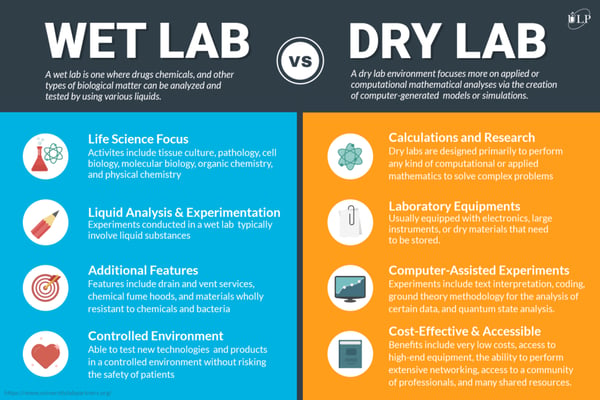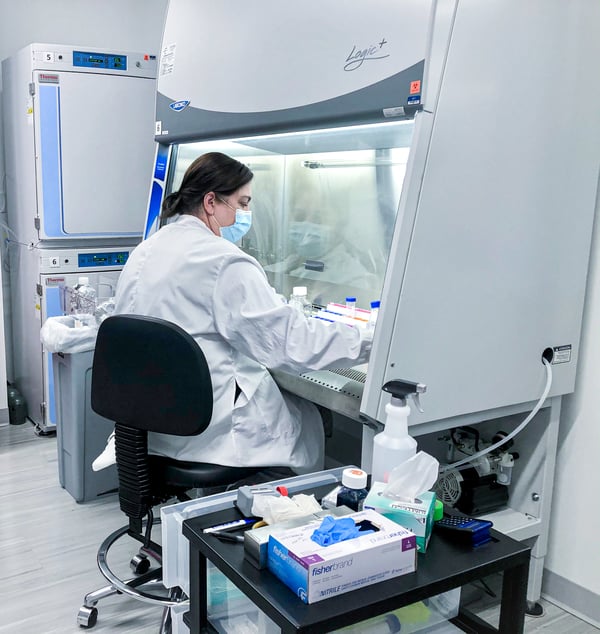Learn whether wet lab or dry lab is perfect for your startup.
When you're thinking of creating a life science startup, the most important decision that you'll need to make is whether your startup will require the use of a dry lab environment or wet lab environment. Many life science startups will use both types of laboratories while developing a new product, medicine, or device.
A wet lab is one where drugs, chemicals, and other types of biological matter can be analyzed and tested by using various liquids. On the other hand, a dry lab environment focuses more on applied or computational mathematical analyses via the creation of computer-generated models or simulations.
Depending on the type of life science innovation you wish to create, it may be necessary to use both lab environments. With a dry lab, you can complete the analysis of the product before starting full development. A wet lab environment is going to be essential if you need to work with any kind of liquid when developing your product. Along with the many differences between these two types of labs, there are also several distinct advantages of each lab type, which you should be wholly aware of before you create your life science startup.
🔬 Read more about: Lab Space for Biotech Startups.
A wet lab is a kind of laboratory that allows you to conduct an array of different types of experiments related to your life science startup. All of these experiments will deal with liquid substances in some manner. The types of experiments that can be performed in a wet lab include everything from the diffraction of light to the creation of a new antibiotic. Many liquid substances that are handled in a wet lab will be chemicals or hazardous products, which is why a wet lab is set up much differently than a dry lab. These rooms have been designed and built to avoid potential issues that could be caused by spillage and contamination.
In order for a laboratory to be considered a wet lab, it will need to meet many strict specifications, most of which are designed to ensure that the environmental conditions in the room are controlled. Some of the many items that are installed in all wet labs include showers, vinyl floors, eye washers, fire alarms, and fire extinguishers. Hot and cold water may also need to be piped in, which can include de-ionized water and reverse osmosis. Some of the additional features that are typically included with a wet lab extend to drain and vent services, chemical fume hoods, and materials that are wholly resistant to chemicals and bacteria. Easy-to-clean sinks and bench countertops will also need to be installed.
If you believe that your life science startup will require the use of a wet lab, it's important to understand that anyone who works in one of these labs will need to have some basic knowledge of various laboratory techniques, which includes experiment-related techniques and safety procedures. If you're trying to create a new medicine and are working with a hazardous substance, it's essential that you understand how to properly handle this substance before you begin work in a wet lab.
Many different types of life science startups will find that a wet lab is necessary for their work. If you're going to be testing chemicals, drugs, or some other kind of biological matter in a gaseous or liquid form, you'll need to use a wet lab for the day-to-day operations of your startup.
🔬 Related: 5 Must Ask Questions for Wet Lab Incubators
The main types of research that are conducted in a wet lab include quantitative chemical analysis via titration and the characterization of enzymes with mass spectrometry. If you're trying to determine whether or not your startup should use a wet lab, these labs allow for such activities as tissue culture, pathology, cell biology, molecular biology, organic chemistry, and physical chemistry.
If your startup is expected to engage in any of these activities in the course of business, you may want to start considering your various options for obtaining wet lab space. The majority of experiments that take place in wet labs follow strict patterns and adhere to straightforward procedures, which helps to eliminate some of the risk that comes with handling hazardous liquids.
Whether your startup is centered around pharmaceuticals or environmental analysis, there are many advantages that you'll receive when you use a wet lab. The primary benefit of using a wet lab is that you can test new technologies and products in a controlled environment. In such an environment, you will be able to make mistakes without the possibility that these mistakes risk the safety of patients. While dry labs can be very beneficial for certain types of research, they don't allow for a controlled environment.
Depending on the size of the wet lab, multiple forms of research can be performed at the same time. When working within a wet lab, you will have the ability to learn how to use new pieces of equipment and tools that may be able to help you further your business goals. The types of equipment that are placed inside a wet lab are oftentimes more advanced than equipment found in a dry lab. The lab design will typically be outfitted with modern freezers, specialized refrigerators, and biosafety cabinets, which allows for easy storage of the substances that you use and create in your course of work. If you anticipate that you will need to work with a gaseous or liquid substance when growing your startup, you should first look to a wet lab for your needs.
🔬 Read about: The Best Wet Lab Incubators in Southern California
%20(1)-1.jpg?width=600&height=450&name=LabonaChip_2021.06.26_(1)%20(1)-1.jpg)
A dry lab is a type of laboratory that involves applied or computational mathematical analyses for a wide array of different applications. These analyses are completed on a computer-generated model, which means that computers and similar types of electronics are the main forms of equipment that are used in a dry lab. This type of analysis is typically performed in a dry lab when it cannot be completed under standard laboratory conditions. For instance, attempting to calculate the boundaries of a black hole would obviously need to occur in a dry lab where computer models can be used to make the necessary calculations.
These laboratories are usually equipped with electronics, large instruments, or dry materials that need to be stored. The many types of computer-assisted experiments that can be performed in a dry lab include text interpretation, coding, ground theory methodology for the analysis of certain data, and quantum state analysis. While these labs are typically meant to be used for analytical and research purposes, they oftentimes require humidity and temperature control, dust control, and fire suppression systems. These systems are in place to ensure that any electronics in the room remain in peak condition.
If you're using a sensitive instrument that needs to maintain a precise calibration, dry labs are typically outfitted with advanced vibration controls that allow for this. Any network communications, sensitive computers, or research instruments that are being used in a dry lab are protected by clean power systems.
If you're creating a medical device for your startup and want to be able to make calculations on what the results of the medical device will be, these calculations can take place in a dry lab. Any kind of computer simulation, analysis, or modeling that needs to be completed for your startup can be performed in a dry lab. While you won't be handling many substances when working in a dry lab, you will be performing work that's just as critical as what's done in a wet lab.
If you need to perform any kind of computational or applied mathematics that will allow you to solve complex problems, this type of research can occur in a dry lab, which isn't possible in a wet lab environment. The activities that occur in a dry lab are usually ones that need to be done before a wet lab is necessary. If you're developing a new medicine with your pharmaceutical startup, you might want to perform some initial analysis before you start to work with chemicals, which could save you a significant amount of time and money.
Since you won't be working with any liquids when in a dry lab, the environmental regulations when in the lab are much less intensive. You'll also be able to work with some of the more advanced computer systems in the world, which may provide you with the tools you need to complete research that's essential to the success of your company. Certain forms of research like analyzing the structure and energy of a small molecule or making any kind of quantum calculation can't be done with a simple desktop computer, which is why a dry lab may be necessary for your startup.
Dry lab experiments can occur within an online or offline mode, which makes them much different than the routine and structured experiments that occur in wet labs. While a wet lab is oftentimes used to test the efficacy of a new medicine or substance, dry labs are designed primarily for calculations and research. The discoveries that are made in a dry lab occur with computer software, while the discoveries that take place in a wet lab are done with chemicals and live specimens. The stark differences between these two lab types make for very unique working environments.

Wet lab equipment and use can be very costly, which will oftentimes be an issue for younger startups. Instead of spending a significant amount of your budget on this equipment, you should heavily consider signing up for a wet lab incubator space. This type of space provides resources that you can essentially rent while you need them. There are many fantastic benefits of using a wet lab incubator space for your startup, which include very low costs, access to high-end equipment, the ability to perform extensive networking, access to a community of professionals, and many shared resources.
🔬 Related: What to Expect When Applying to a Wet Lab Incubator
If you believe that a wet lab incubator is right for your startup, it's recommended that you apply for space at University Lab Partners. Their spacious facilities offer flexibility for growing startups, teams, and individuals who may require wet lab space. The many shared resources available to startups at this incubator include fume hoods, tissue culture labs, and a freezer farm. Apply for a private lab suite or bench today to get your company up and running!
Download The Ultimate Guide to Wet Lab Incubators in Southern California, a handbook to assist life science start-ups through the entire decision-making process to find wet lab space.
Download Now